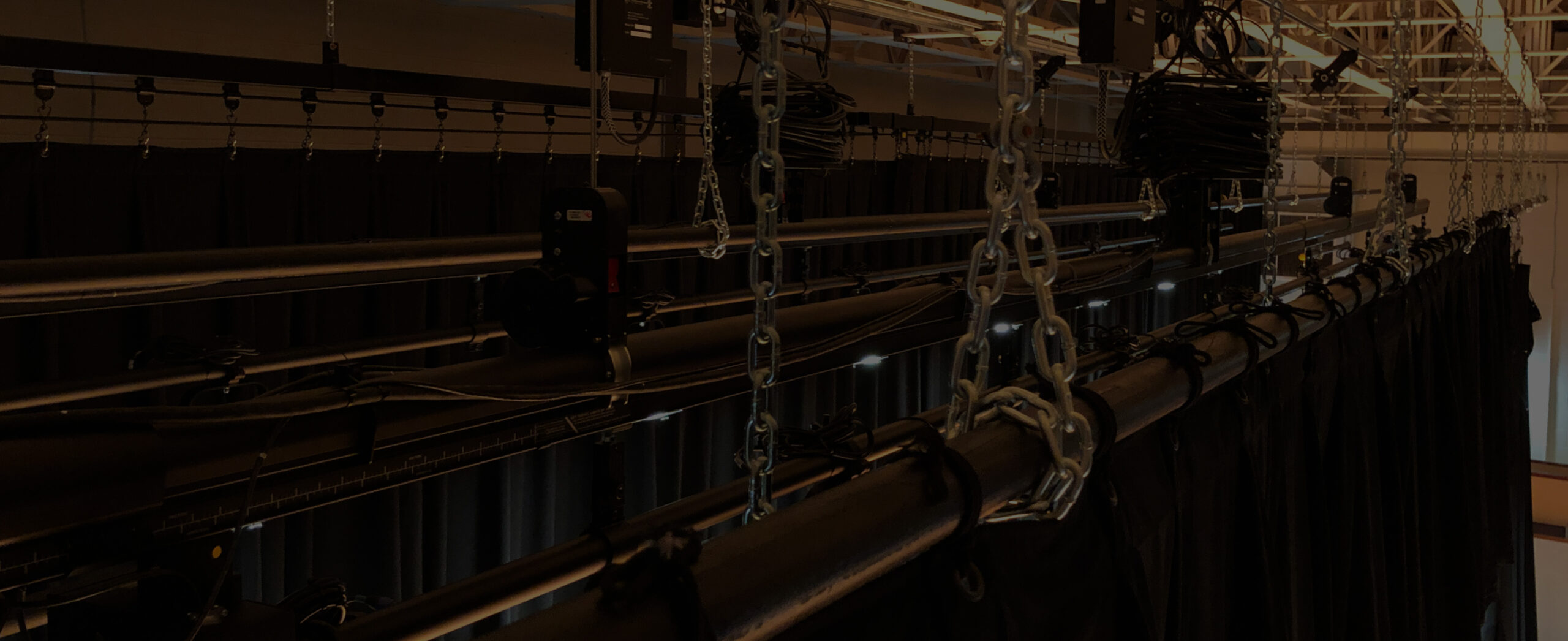
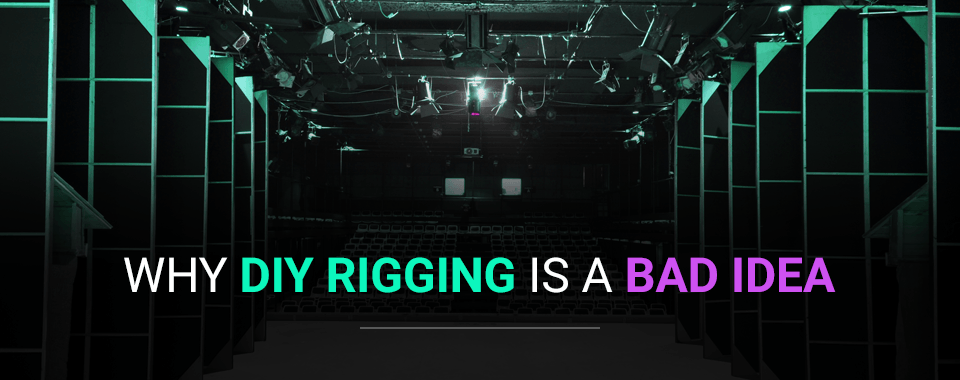
Integrating a new AVL system into your auditorium, theater or venue is an exciting and effective way to enhance every performance or show. A dynamic AVL system can transform any live event into an immersive, engaging experience your audiences will never forget. Unfortunately, many venue operators mistakenly believe they can achieve their desired results by rigging the AVL system and other equipment themselves. However, do-it-yourself AVL rigging is a dangerous undertaking that can compromise the safety and integrity of your auditorium.
The experts at Illuminated Integration appreciate the fact that theater managers enjoy being as hands-on as possible when it comes to improving the audio, video and lighting of their auditorium. Though other areas may warrant an independent approach, theater rigging is not one of them. We do not recommend DIY AV or equipment rigging because it is a complicated and dangerous process. Knowledge is always your most useful tool, which is why we’ve created this informative guide that highlights the reasons why DIY rigging is a bad idea.
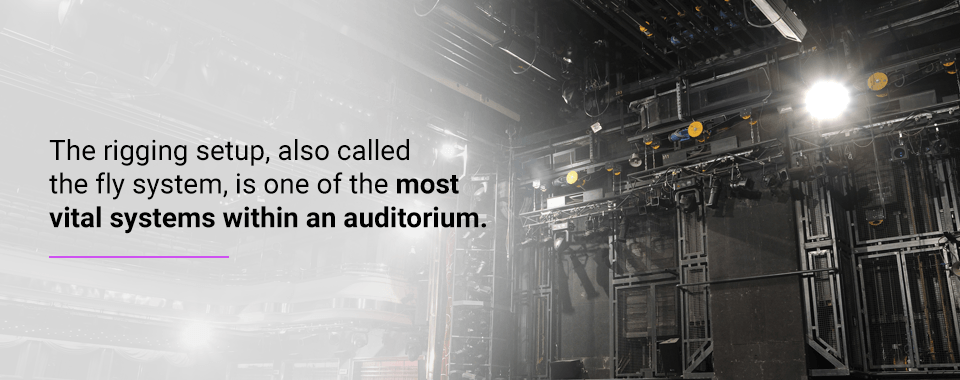
The rigging setup, also called the fly system, is one of the most vital systems within an auditorium. These systems consist of a series of machines such as ropes and pulleys that support the safe operation of stage lighting, scenery backdrops, props and people as they get hoisted, positioned or moved across or above the stage. Theatrical rigging plays a vital role in creating and sustaining the visual effects that provide an immersive atmosphere which keeps audiences engaged. Without a dynamic rigging system, performance quality may suffer.
There is no such thing as a “one-size-fits-all” rigging system design suitable for every space. Instead, rigging systems are customizable to the needs and spatial limitations of the theater itself. Though all rigging systems support the AVL system and other theatrical equipment or components, it’s essential to consider the type of system and its capabilities. Some systems may not integrate properly into the structure of the auditorium, while others may fit the space, but cannot safely support the rig.
Although the rigging system is essential, the proper installation of the system is just as critical to its success and safety. Avoiding professional installation by purchasing a theater rigging system and installing it can be dangerous and ineffective, even if you believe you are familiar with stage rigging basics. Not only will the system not function properly, but there are also standards and safety protocols to meet when rigging a stage. Failure to follow these rules may result in damaged equipment or even severe injury.
“Organized chaos” is often an appropriate way to describe theater operations. Many productions involve a crew of individuals on and off stage who must accomplish their specific duties in a carefully timed and planned way to successfully keep the event running without error. Unfortunately, even the most trained teams can face safety concerns while executing their duties. The Occupational Safety and Health Administration, or OSHA, has taken measures to protect those in a theatrical setting by issuing regulations and requirements for rigging systems within auditoriums.
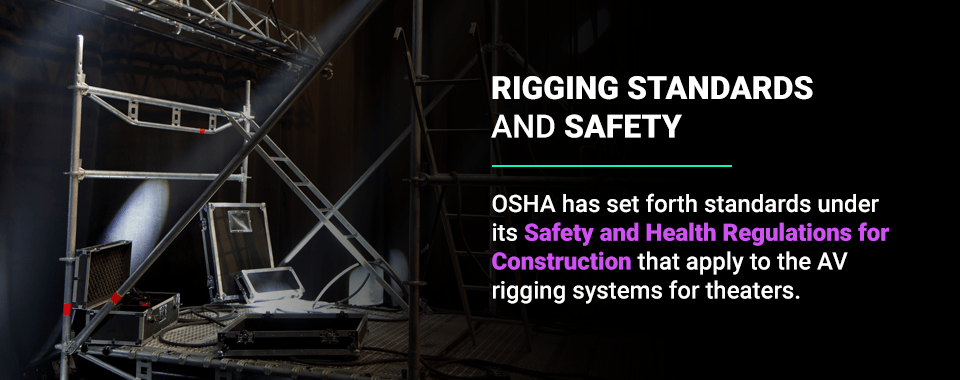
OSHA has set forth standards under its Safety and Health Regulations for Construction that apply to the AV rigging systems for theaters:
There are other OSHA rigging regulations in place to protect rigging users from accidental falls. OSHA’s standard for the construction industry, which includes rigging operations used within the theater, requires protective measures to be in place to safeguard individuals from falls of six feet or more. Industry standards, however, mandate fall protection for drops measuring four feet or higher. You should also note any potential safety hazards for children or individuals with disabilities who may also interact with the rigging equipment.
OSHA’s guidelines also suggest some strategies for enhancing the safety of those interacting with rigging systems. Place special lighting in hazardous areas like the catwalk to provide pathway illumination. Use belt restraint systems and standard fall arrest systems when possible to safeguard those operating the rigging system from above. Temporary or permanent handrails, guardrails and balcony rails should be in place to provide increased safety and protection.
Providing the best possible protection to everyone installing, maintaining, repairing, operating or otherwise interacting with your theater rigging system requires following the industry standards, regulations and requirements diligently. Failure to comply with these rules could result in serious injury as well as failed safety inspections. Along with these standards, it’s wise to also integrate other responsible rigging safety practices into your venue operations.
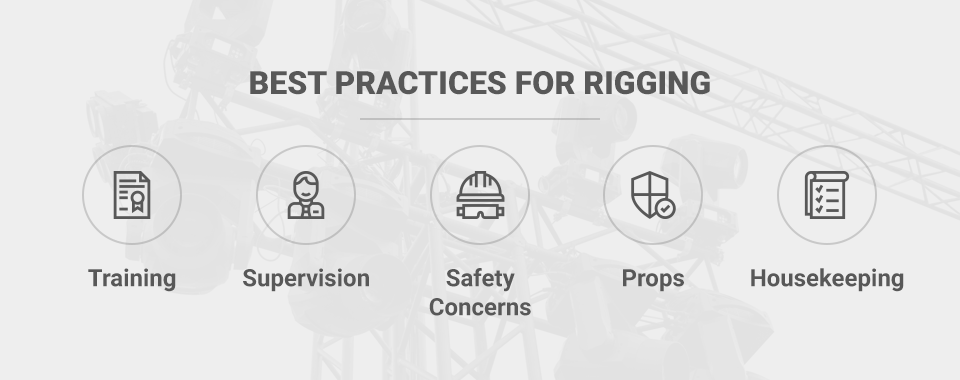
Theater rigging is inherently dangerous. Although this fact should not deter you from integrating a new or replacement rigging system into your auditorium, it is imperative that you understand the complex science and engineering that enables a rigging system to operate correctly and safely. Similar to all other forms of machinery, a failure to fully understand the principles involved can quickly result in the destruction of property and injury to others. After a qualified team has installed your rigging system, you should continue to operate the system responsibly.
Along with keeping the equipment, props and rigging system fully functional and free from damage, the primary reason you should consistently acknowledge and act upon these five points is to ensure the safety of everyone who interacts with or approaches the vicinity of the stage and rigging system. Following the best rigging practices possible safeguards individuals against careless mistakes, allows for smooth, streamlined operation and enables crew and supervisors to swiftly respond to emergencies should they arise.
Like any other significant project, you don’t want to rush into an installation until you are sure your rigging design not only meets the intended needs of event productions, but also suits the structural limitations of the facility. You should also establish a communication protocol and ensure its consistent use throughout the project. Before you seek out experts to help with your rigging installation, consider these four essential questions.
As you visualize your completed auditorium, take a moment to consider the events you wish to showcase on stage, both now and in the future. Many facility managers understand the importance of AVL integration, but they may not realize the scope of installation needed to achieve their goals. Before agreeing on a rigging setup, your team should have a clear and consistent vision for the final product so experts can design an AVL build that suits your needs perfectly.
Defining the scope of this project may also include identifying other groups who may get involved or affected by the planning and installation of the rigging system. If another party uses the facility — for instance, a religious organization that uses the school auditorium for weekend worship — or if the project will impact another party in any way, notify them of the installation’s scheduled duration. You should also ensure you’ve obtained approval from appropriate parties and that the equipment meets all legislative compliance standards.
Though you may aspire to have a completed theater rigging system that will allow dozens upon dozens of vibrant productions to take center stage, you must also take note of any structural limitations your facility may have. Every facility will be different, which means the size, age and integrity of your theater may all be factors that affect the final product. Don’t worry — even without an appropriate rigging infrastructure in place, Rigging designers can customize your build to meet the needs of your unique facility.
One significant problem that will likely arise during a DIY rigging installation is a failure to consider the environmental conditions that may affect the structure itself. Although some projects may have literal environmental conditions that impact the installation process, you should also understand how other elements can negatively affect your project. Poor visibility, variable surfaces, close quarters and tight schedules can all create conditions that jeopardize the safety of those involved.
Clear, effective communication is always a vital element in the success and safety of any construction project. Experts will need to establish communication protocols for all involved or impacted by this project. Exceptional rigging professionals may also teach you and your team communication tools to use after the installation wraps up, such as proper hand signals to use when operating the rigging system.
These are only a few of the many topics you and your team should address when installing or replacing a new theater rigging system in your auditorium. Because this endeavor is complicated in both concept and implementation, a do-it-yourself rigging installation or upgrade can quickly turn into a failed attempt. The team you choose to perform expert AV rigging installation should understand the full scope of your AVL project, perform a thorough assessment of the space’s infrastructure, identify hazardous conditions and use effective communication protocols.
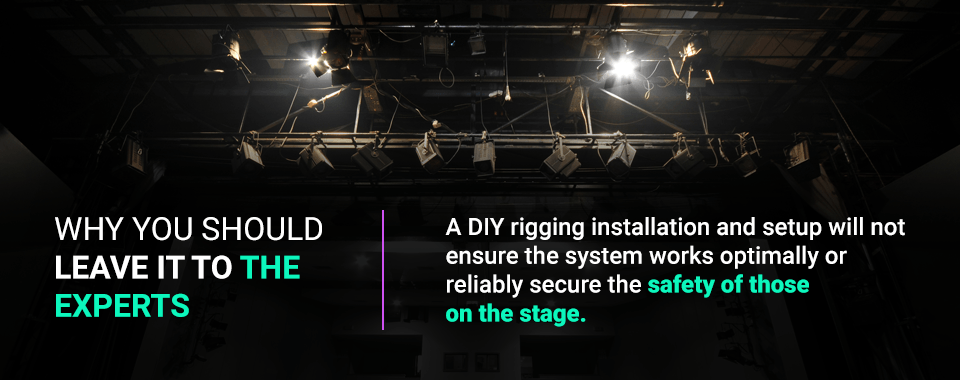
Whether you’re remodeling your theater or constructing a new auditorium from the ground up, you should avoid the temptation to complete the rigging design and installation yourself at all costs. Failure to meet rigging standards and ensure compliance and safety not only creates a dangerous situation, but it also may cause your auditorium not to meet the minimum inspection standards. Most importantly, you want your theater rigging to dramatically enhance every performance and event that takes place in your auditorium.
As one of the critical components your performers and audience will rely on, your rigging system must function efficiently and safely for years. A DIY rigging installation and setup will not ensure the system works optimally or reliably secure the safety of those on the stage. This system is an investment in the quality of all events that will take place on your stage. There’s no doubt about it — you should leave the design and installation of your rigging system to people who know how to do it right the first time.
The team of experts at Illuminated Integration specialize in both static and motorized rigging systems. Using our extensive knowledge and experience, we customize one-of-a-kind AVL+Rigging design builds to your theater’s size and needs. Our designers will meet with your team to bring your vision to life with 3D renderings. You’ll have full control of the design to make the adjustments you believe will suit your theater best. Once you’re pleased with the design, our team will integrate your custom rigging system perfectly into your space.
We believe every excellent performance deserves a showcase that is just as remarkable. Illuminated Integration understands the diverse productions taking place in a theater require an AVL build that is just as versatile. Our turnkey AVL+Rigging solutions reflect the passion, innovation and originality we devote to each AVL design so the result provides audiences with an immersive experience they’ll never forget.
A high-quality stage rigging system from Illuminated Integration will transform your theater like never before. The rigging requirements you request will instantly benefit your production team, streamlining stage work as the system smoothly allows stagehands to manipulate props, lighting and scenery. From guest speaker engagements to vibrant musicals, every event on your stage will benefit from our dynamic rigging design that exceeds your expectations and allows you to expand your stage capabilities as far as you can imagine.
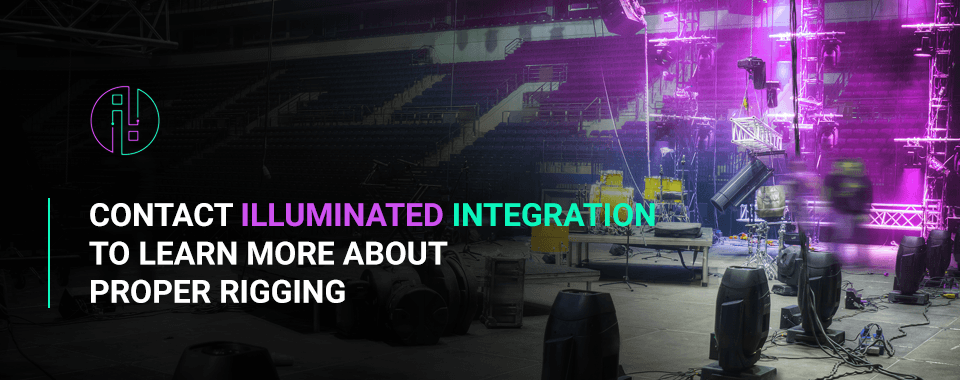
If you are revitalizing the rigging design for your stage or are equipping your facility with its first rigging system, we urge you to avoid a DIY approach and instead seek the knowledge and experience that has made Illuminated Integration a trusted name in custom AVL+Rigging design and installation. We can create versatile rigging systems and precisely tailor them to any facility and function imaginable.
Don’t jeopardize your theater’s future by attempting a DIY rigging installation. Let the experts at Illuminated Integration help you design and integrate a dynamic rigging system into your venue. Speak with one of our design experts today and discover how you can dramatically transform your theater, auditorium or events facility into a fantastic space.
Updated on 2/2/2021